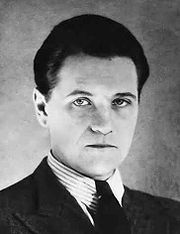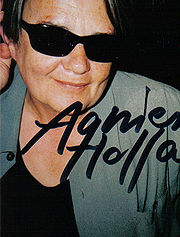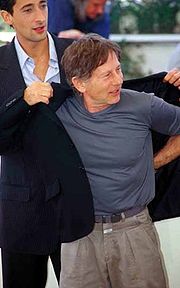
Cinema of Poland
Encyclopedia

.jpg)

Cinematography
Cinematography is the making of lighting and camera choices when recording photographic images for cinema. It is closely related to the art of still photography...
, and it has universal achievements, even though Polish movies tend to be less commercially available than movies from several other European nations.
From 1955 onwards, the works of directors of the so-called Polish Film School
Polish Film School
Polish Film School refers to an informal group of Polish film directors and screenplay writers active between 1955 and approximately 1963.The group was under heavy influence of Italian neorealists. It took advantage of the liberal changes in Poland after the 1956 to portray the complexity of...
had a great influence on the contemporary trends such as French New Wave
French New Wave
The New Wave was a blanket term coined by critics for a group of French filmmakers of the late 1950s and 1960s, influenced by Italian Neorealism and classical Hollywood cinema. Although never a formally organized movement, the New Wave filmmakers were linked by their self-conscious rejection of...
, Italian neorealism
Italian neorealism
Italian neorealism is a style of film characterized by stories set amongst the poor and working class, filmed on location, frequently using nonprofessional actors...
or even late Classical Hollywood cinema
Classical Hollywood cinema
Classical Hollywood cinema or the classical Hollywood narrative, are terms used in film history which designates both a visual and sound style for making motion pictures and a mode of production used in the American film industry between roughly the 1910s and the early 1960s.Classical style is...
. After World War II
World War II
World War II, or the Second World War , was a global conflict lasting from 1939 to 1945, involving most of the world's nations—including all of the great powers—eventually forming two opposing military alliances: the Allies and the Axis...
, despite censorship
Censorship in the People's Republic of Poland
Censorship in the People's Republic of Poland was primarily performed by the Polish Main Office of Control of Press, Publications and Shows , a governmental institution created in 1946 by the pro-Soviet Provisional Government of National Unity with Stalin's approval and backing, and renamed in 1981...
, filmmakers like Roman Polanski
Roman Polanski
Roman Polanski is a French-Polish film director, producer, writer and actor. Having made films in Poland, Britain, France and the USA, he is considered one of the few "truly international filmmakers."...
, Krzysztof Kieślowski
Krzysztof Kieslowski
Krzysztof Kieślowski was an Academy Award nominated influential Polish film director and screenwriter, known internationally for The Double Life of Veronique and his film cycles The Decalogue and Three Colors.-Early life:...
, Agnieszka Holland
Agnieszka Holland
Agnieszka Holland is a Polish film and TV director and screenwriter. Best recognized for her highly political contributions to Polish cinema, Holland is one of Poland's most prominent filmmakers.-Personal life:...
, Andrzej Wajda
Andrzej Wajda
Andrzej Wajda is a Polish film director. Recipient of an honorary Oscar, he is possibly the most prominent member of the unofficial "Polish Film School"...
, Andrzej Żuławski impacted the development of the cinematography. In the most recent years, while no longer and struggling with censorship, and with a large number of independent filmmakers of all genres, the Polish productions tend to be more inspired by the American film.
Early history
The first cinemaMovie theater
A movie theater, cinema, movie house, picture theater, film theater is a venue, usually a building, for viewing motion pictures ....
in Poland (then occupied by the Russian Empire
Russian Empire
The Russian Empire was a state that existed from 1721 until the Russian Revolution of 1917. It was the successor to the Tsardom of Russia and the predecessor of the Soviet Union...
) was founded in Łódź in 1899, several years after the invention of the Cinematograph. Initially dubbed Living Pictures Theatre, it gained much popularity and by the end of the next decade there were cinemas in almost every major town of Poland. Arguably the first Polish filmmaker was Kazimierz Prószyński
Kazimierz Prószynski
Kazimierz Prószyński was a Polish inventor active in the field of cinema. He patented his first film camera, called Pleograph , before the Lumière brothers, and later went on to improve the cinema projector for the Gaumont company, as well as invent the widely used hand-held Aeroscope...
, who filmed various short documentaries in Warsaw
Warsaw
Warsaw is the capital and largest city of Poland. It is located on the Vistula River, roughly from the Baltic Sea and from the Carpathian Mountains. Its population in 2010 was estimated at 1,716,855 residents with a greater metropolitan area of 2,631,902 residents, making Warsaw the 10th most...
. His pleograph
Pleograph
Pleograph was an early type of movie camera constructed in 1894, before those made by the Lumière brothers, by Polish inventor Kazimierz Prószyński. Prószyński later constructed the first hand held camera called an Aeroscope....
film camera has been patented already before the Lumière brothers' invention and he is credited as the author of the earliest surviving Polish documentary titled Ślizgawka w Łazienkach (Skating-rink in the Royal Baths), as well as the first short narrative films Powrót birbanta (Rake's return home) and Przygoda dorożkarza (Cabman's Adventure), both created in 1902. Another pioneer of cinema was Bolesław Matuszewski, who became one of the first filmmakers working for the Lumière company - and the official "cinematographer" of the Russian tsars in 1897.
The earliest surviving feature film
Feature film
In the film industry, a feature film is a film production made for initial distribution in theaters and being the main attraction of the screening, rather than a short film screened before it; a full length movie...
, the Antoś pierwszy raz w Warszawie (Antoś for the First Time in Warsaw) was made in 1908 by Antoni Fertner. The date of its première
Premiere
A premiere is generally "a first performance". This can refer to plays, films, television programs, operas, symphonies, ballets and so on. Premieres for theatrical, musical and other cultural presentations can become extravagant affairs, attracting large numbers of socialites and much media...
, October 22, 1908, is considered the founding date of Polish film industry
Film industry
The film industry consists of the technological and commercial institutions of filmmaking: i.e. film production companies, film studios, cinematography, film production, screenwriting, pre-production, post production, film festivals, distribution; and actors, film directors and other film crew...
. Soon Polish artists started experimenting with other genres of cinema: in 1910 Władysław Starewicz made one of the first animated cartoon
Animated cartoon
An animated cartoon is a short, hand-drawn film for the cinema, television or computer screen, featuring some kind of story or plot...
s in the world - and the first to use the stop motion
Stop motion
Stop motion is an animation technique to make a physically manipulated object appear to move on its own. The object is moved in small increments between individually photographed frames, creating the illusion of movement when the series of frames is played as a continuous sequence...
technique, the Piękna Lukanida (Beautiful Lukanida). By the start of World War I
World War I
World War I , which was predominantly called the World War or the Great War from its occurrence until 1939, and the First World War or World War I thereafter, was a major war centred in Europe that began on 28 July 1914 and lasted until 11 November 1918...
the cinema in Poland was already in full swing, with numerous adaptations of major works of Polish literature
Polish literature
Polish literature is the literary tradition of Poland. Most Polish literature has been written in the Polish language, though other languages, used in Poland over the centuries, have also contributed to Polish literary traditions, including Yiddish, Lithuanian, Ukrainian, Belarusian, German and...
screened (notably the Dzieje grzechu, Meir Ezofowicz and Nad Niemnem
Nad Niemnem
Nad Niemnem is a Positivist novel written by Eliza Orzeszkowa in 1888 during the foreign Partitions of Poland. Its main purpose was to present the Polish society and its own internal dynamics as they were in mid–18th century, in reference to the Polish January Uprising against the Russian occupation...
.
During the WWI the Polish cinema crossed borders. Films made in Warsaw or Vilna were often rebranded with German language intertitle
Intertitle
In motion pictures, an intertitle is a piece of filmed, printed text edited into the midst of the photographed action, at various points, generally to convey character dialogue, or descriptive narrative material related to, but not necessarily covered by, the material photographed.Intertitles...
s and shown in Berlin
Berlin
Berlin is the capital city of Germany and is one of the 16 states of Germany. With a population of 3.45 million people, Berlin is Germany's largest city. It is the second most populous city proper and the seventh most populous urban area in the European Union...
. That was how a young actress Pola Negri
Pola Negri
Pola Negri was a Polish stage and film actress who achieved worldwide fame for her tragedienne and femme fatale roles from the 1910s through the 1940s during the Golden Era of Hollywood film. She was the first European film star to be invited to Hollywood, and became a great American star. She...
(born Barbara Apolonia Chałupiec) gained fame in Germany and eventually became one of the European super-stars of silent film
Silent film
A silent film is a film with no synchronized recorded sound, especially with no spoken dialogue. In silent films for entertainment the dialogue is transmitted through muted gestures, pantomime and title cards...
.
After WWII
Graduates of world-renowned Łódź Film SchoolNational Film School in Lódz
The Leon Schiller National Higher School of Film, Television and Theatre in Łódź is the most notable academy for future actors, directors, photographers, camera operators and TV staff in Poland...
include some of the icons of the world cinematography, e.g., Roman Polanski
Roman Polanski
Roman Polanski is a French-Polish film director, producer, writer and actor. Having made films in Poland, Britain, France and the USA, he is considered one of the few "truly international filmmakers."...
(Knife in the Water
Knife in the Water (film)
Knife in the Water is a 1962 Polish drama film directed by Roman Polański. It is Polanski's first feature film, featuring three characters in a story of rivalry and sexual tension.-Plot:...
, Rosemary's Baby
Rosemary's Baby (film)
Rosemary's Baby is a 1968 American horror film written and directed by Roman Polanski, based on the bestselling 1967 novel Rosemary's Baby by Ira Levin...
, Frantic
Frantic (film)
Frantic is a 1988 thriller film directed by Roman Polanski and starring Harrison Ford and Emmanuelle Seigner.- Synopsis :Harrison Ford plays Dr. Richard Walker, a surgeon visiting Paris with his wife Sondra for a medical conference. At their hotel, she is unable to unlock her suitcase, and Walker...
, The Pianist
The Pianist (2002 film)
The Pianist is a 2002 biographical war film directed by Roman Polanski, starring Adrien Brody. It is an adaptation of the autobiography of the same name by Jewish-Polish musician Władysław Szpilman...
) and Krzysztof Zanussi
Krzysztof Zanussi
Krzysztof Zanussi, is a Polish producer and film director.He is a professor of European film at the European Graduate School in Saas-Fee, Switzerland where he conducts a summer workshop...
(a leading director of the so-called cinema of moral anxiety of the 1970s).
Andrzej Wajda
Andrzej Wajda
Andrzej Wajda is a Polish film director. Recipient of an honorary Oscar, he is possibly the most prominent member of the unofficial "Polish Film School"...
's films offer insightful analyses of the universal element of the Polish experience - the struggle to maintain dignity under the most trying circumstances. His films defined several Polish generations. In 2000, Wajda was awarded an honorary Oscar
Academy Awards
An Academy Award, also known as an Oscar, is an accolade bestowed by the American Academy of Motion Picture Arts and Sciences to recognize excellence of professionals in the film industry, including directors, actors, and writers...
for his overall contributions to the cinematography.
It is also important to note that during the 80's, the People's Republic of Poland instituted the martial law
Martial law in Poland
Martial law in Poland refers to the period of time from December 13, 1981 to July 22, 1983, when the authoritarian government of the People's Republic of Poland drastically restricted normal life by introducing martial law in an attempt to crush political opposition to it. Thousands of opposition...
to vanquish and censor all forms of opposition against the communist rule of the nation, including outlets such as cinema and radio. A notable film to have emerged during this period was Ryszard Bugajski
Ryszard Bugajski
Ryszard Bugajski is a Polish film director and screenwriter. He has directed 23 films and television shows since 1972. His film Interrogation was entered into the 1990 Cannes Film Festival.-Selected filmography:...
's 1982 film Interrogation
Interrogation (film)
Interrogation is a 1982 Polish crime film directed by Ryszard Bugajski. Due to its anti-communist themes, the Polish communist government banned the film from public viewing for over seven years, until the 1989 dissolution of the Eastern Bloc allowed it to see the light of day...
(Przesluchanie), which depicts the story of an unfortunate woman (played by Krystyna Janda) who is arrested and tortured by the secret police into confessing a crime she knows nothing about. The anti-communist nature of the film brought about the film's over seven-year ban. In 1989, the ban was repealed after the overthrow of the Communist government in Poland, and the film was shown in theaters for the first time later that year. The film is still lauded today for its audacity in depicting the cruelty of the Stalinist regime, as many artists feared persecution during that time.
In the 1990s, Krzysztof Kieślowski
Krzysztof Kieslowski
Krzysztof Kieślowski was an Academy Award nominated influential Polish film director and screenwriter, known internationally for The Double Life of Veronique and his film cycles The Decalogue and Three Colors.-Early life:...
won a universal acclaim with productions such as The Decalogue
The Decalogue
The Decalogue is a 1989 Polish television drama series directed by Krzysztof Kieślowski and co-written by Kieślowski with Krzysztof Piesiewicz, with music by Zbigniew Preisner...
(made for television), The Double Life of Véronique
The Double Life of Véronique
The Double Life of Véronique is a 1991 French- and Polish-language film directed by Krzysztof Kieślowski, co-written by Kieślowski and Krzysztof Piesiewicz, starring Irène Jacob, with original music by Zbigniew Preisner. The film was Kieślowski's first to be produced partly outside Poland.A...
and the Three Colors
Three Colors
The Three Colours Trilogy is the collective title of three films – a trilogy – directed by Krzysztof Kieślowski, two made in French and one primarily in Polish: Trois couleurs: Bleu , Trzy kolory: Biały , and Trois couleurs: Rouge...
trilogy.
A large number of Polish film directors (e.g., Agnieszka Holland
Agnieszka Holland
Agnieszka Holland is a Polish film and TV director and screenwriter. Best recognized for her highly political contributions to Polish cinema, Holland is one of Poland's most prominent filmmakers.-Personal life:...
and Janusz Kamiński
Janusz Kaminski
Janusz Zygmunt Kamiński is a Polish cinematographer and film director. He has photographed all of Steven Spielberg's films since 1993's Schindler's List.-Life and career:...
) have worked in American studios.
Polish animated films - e.g., those by Jan Lenica
Jan Lenica
Jan Lenica was a Polish graphic designer and cartoonist.A graduate of the Architecture Department of Warsaw Polytechnic, Lenica became a poster illustrator and a collaborator on the early animation films of Walerian Borowczyk. From 1963 - 1986 he lived and worked in France, while from 1987 he...
and Zbigniew Rybczyński
Zbigniew Rybczynski
Zbigniew Rybczyński is a Polish filmmaker who has won numerous prestigious industry awards both in the United States and internationally. He was also a teacher of cinematography, and digital cinematography. Currently he is a researcher of blue and greenscreen compositing technology at Ultimatte...
(Oscar, 1983) - have a long tradition and derive inspiration from Poland's graphic arts.
Directors


See also
- Cinema of the world
- Polish film schoolPolish Film SchoolPolish Film School refers to an informal group of Polish film directors and screenplay writers active between 1955 and approximately 1963.The group was under heavy influence of Italian neorealists. It took advantage of the liberal changes in Poland after the 1956 to portray the complexity of...
- National Film School in Łódź
- World cinemaWorld cinemaWorld cinema is a term used primarily in English language speaking countries to refer to the films and film industries of non-English speaking countries. It is therefore often used interchangeably with the term foreign film...
- History of cinema
- List of famous Poles
External links
- Polish Film Institute
- Internet Polish Movie Database
- Polish Cinema Database
- Short overview of Polish cinema
- Film theory in Poland before World War II Marek Haltof, Canadian Slavonic Papers, March–June 1998.
- european-films.net - Reviews, trailers, interviews, news and previews of recent and upcoming European films (in English)

